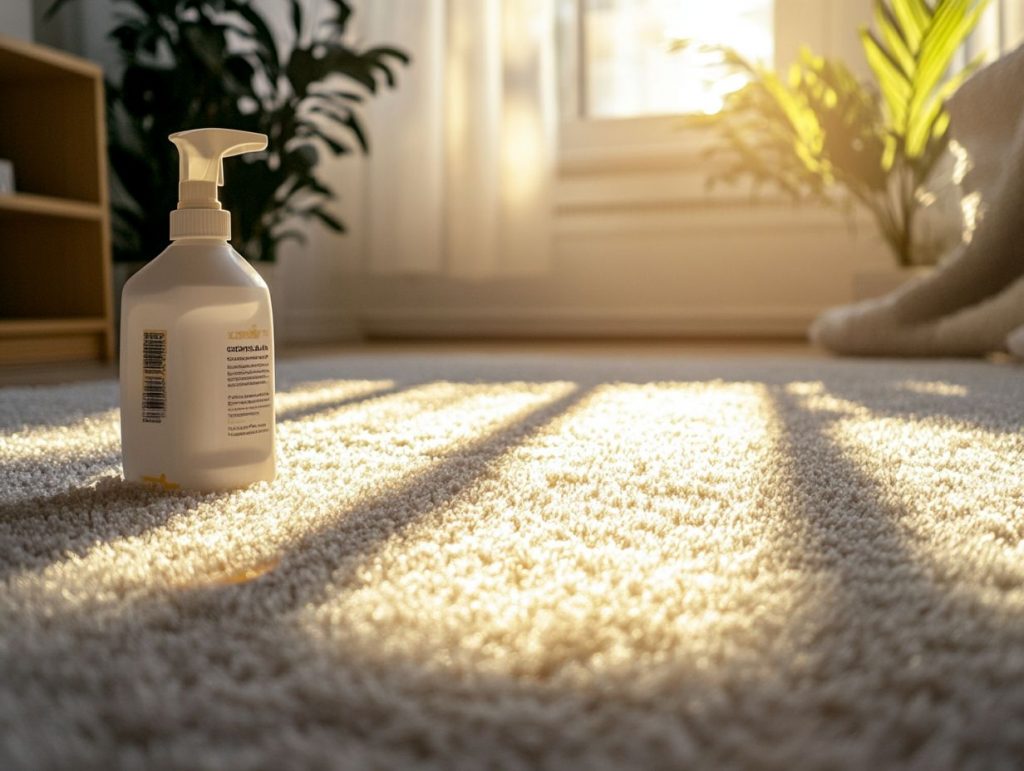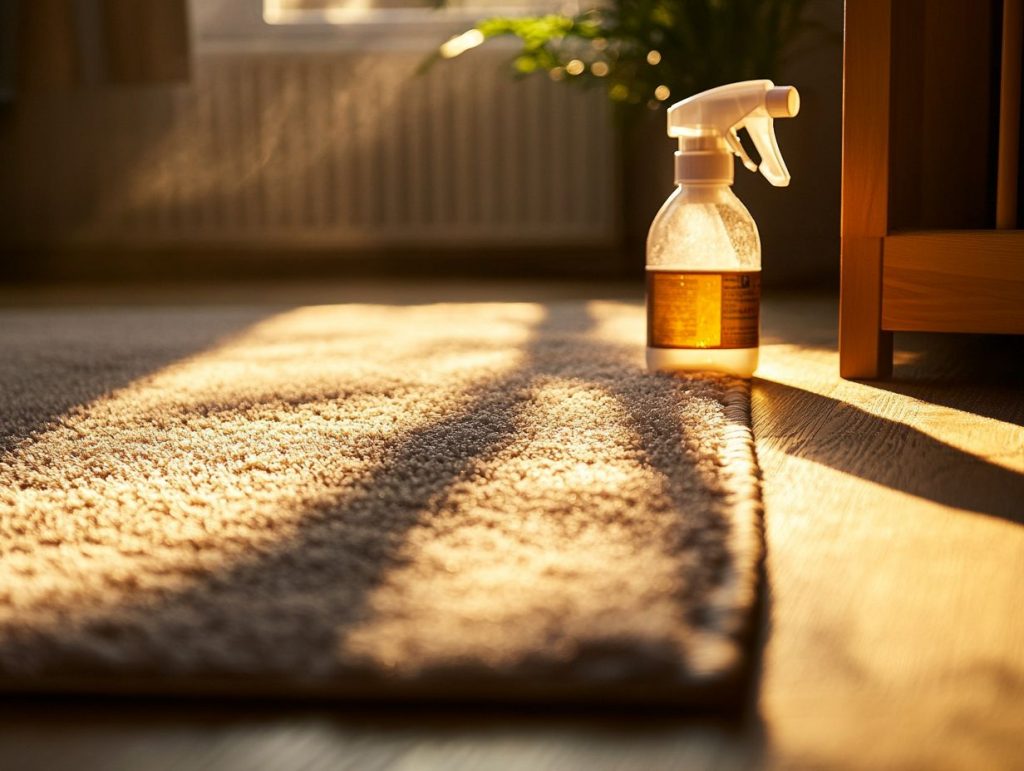-
The Role of Deodorisers in Carpet Cleaning: When and How to Use Them
Carpets are a beloved part of our homes but can also be breeding grounds for unpleasant odours. Understanding deodorisers is critical to maintaining a fresh and inviting space.
This article explores deodorisers and how they work, guiding you on when to use them based on odour sources and severity. It also looks at the different types of deodorisers—chemical and natural—along with practical application techniques and tips.
Discover best practices for preventing odours, ensuring your carpets stay fresh longer.

Why Do Professional Carpet Cleaners Apply Deodorisers?
Understanding deodorisers in carpet cleaning is key to keeping your home fresh and inviting. These cleaning agents don’t just tackle odours; they also work wonders as fabric fresheners and for upholstery care.
By effectively neutralising scents, you can ensure your carpets remain free from unpleasant odours from pets, smoke, or mould. Using the right deodorisers enhances indoor air quality and significantly impacts your overall cleaning routine.
Knowing how to choose and use these products is essential for achieving the optimal carpet freshness and hygiene you’re after.
What are Deodorisers and How Do They Work?
Deodorisers are your go-to products for tackling odours and boosting the freshness of your carpets and upholstery. They work in several ways, such as neutralising scents, breaking down odour sources with enzymes, and masking unwanted smells. Knowing how these methods work will help you choose the right deodorising spray or cleaning agent to meet your needs.
Several types of deodorisers are available on the market, each with a unique composition and purpose. Chemical deodorisers often contain synthetic fragrances and compounds such as alcohol or ammonia. They can overpower odours but might not effectively tackle the root of the problem.
On the other hand, natural options like bicarbonate of soda and essential oils allow you to harness the power of nature to absorb odours while delivering a pleasant scent without harsh chemicals. Each type has its strengths, with natural deodorisers generally being gentler on surfaces and the environment while boosting your cleaning routine.
Choosing the right product can make your living spaces fresher while keeping things clean and safe.
When to Use Deodorisers
Knowing when to use deodorisers is vital to keeping your home smelling fresh. Regularly check your carpets and upholstery for unpleasant odours, like pesky pet smells or lingering smoke. These can sneak in from various places, so staying on top is important.
Establishing a cleaning schedule helps you catch these odours early, allowing you to take care of them before they become a bigger issue. This way, you can maintain a clean and inviting living environment.
Identifying Odor Sources and Severity
Identifying the sources and severity of pesky household odours is the first step in effective carpet cleaning and deodorisation. Common culprits include spills, pet accidents, mould growth, and dust mite infestations, all of which can lead to stubborn smells if you don’t tackle them immediately. With some targeted cleaning tips and strategies for stain removal, you can effectively deal with these issues and keep your home smelling fresh.
You can combine visual inspections with a little sniff test to understand how serious those odours are. Check for stained areas, damp spots, or any visible mould, and use your sense of smell to judge just how intense the odours are.
Professional cleaning strategies recommend whipping up a mixture of water and vinegar for a natural deodorising solution or trying out enzyme-based cleaners for those organic stains. Regular vacuuming with a HEPA filter helps reduce dust and allergens, making your home healthier.
It’s crucial to tackle these odour sources immediately to prevent them from settling into your carpets and fabrics.

Types of Deodorisers
You’ll find that deodorisers fall into two main categories: chemical and natural. Each has its unique properties and uses.
Chemical deodorisers usually contain synthetic ingredients that provide instant scent masking or odour neutralisation. On the other hand, natural deodorisers rely on essential oils or plant-based components to achieve similar results while being more environmentally friendly.
Knowing the differences between these types can help you make informed choices about cleaning solutions.
Chemical vs. Natural Deodorisers
When comparing chemical and natural deodorisers, it’s essential to consider factors like how well they clean, their fragrance profiles, and whether they’re allergy-friendly. Chemical deodorisers can quickly mask and eliminate odours but might also leave behind residues or allergens. On the flip side, natural deodorisers often come with pleasant scents and no harmful side effects, making them a go-to for anyone with sensitivities.
You might notice that while chemical options can swiftly neutralise unpleasant smells in places like your kitchen or bathroom, they often leave an artificial scent that some people find overwhelming. Natural deodorisers, especially those made from essential oils, can freshen the air without harsh chemicals, although you may need to apply them more often to keep the freshness going.
Depending on your setting—such as a child’s bedroom versus a pet owner’s space—one type might work better for you. Many customers point out how crucial it is for a product to have long-lasting cleaning effectiveness, so checking whether it is just masking odours or getting rid of them for good is essential.
How to Use Deodorisers in Carpet Cleaning
Using deodorisers in carpet cleaning effectively means knowing the best application techniques for the best results. Whether you’re reaching for a deodorising spray or an enzymatic cleaner, following the proper product application methods is crucial to ensure thorough treatment and maximum effectiveness.
Moreover, using the right cleaning equipment enhances the overall process, making it easier to keep your carpets and upholstery fresh and clean.
Application Techniques and Tips
With a few handy tips, you can enhance the effectiveness of deodorisers while keeping your carpet fibres safe. First, always test any new cleaning solution on a small, hidden area before you go all in with it. Incorporating deodorisers into your regular cleaning routine can help maintain your space’s fresh and hygienic feel.
One great method is to dilute the deodoriser according to the manufacturer’s instructions. This way, you strike the perfect balance between potency and safety for your carpets. Timing is also crucial—apply the deodoriser right after vacuuming and let it sit to soak up those odours.
Mix and match cleaning techniques with your deodorisers, such as steam or dry shampooing. This combination can do wonders for overall cleanliness and help keep that fresh scent around for longer. Remember, the right approach revitalises your carpets and boosts your home’s atmosphere.
Preventing Odors in Carpets
Preventing odours in your carpets is all about being proactive. Focus on regular maintenance and set up an effective cleaning schedule.
By following best practices for stain prevention—such as spot cleaning immediately and managing household odours effectively—you can reduce the chances of unpleasant smells taking hold in the first place.
This approach helps keep your carpet in top condition and creates a fresher atmosphere in your home.
Best Practices for Maintaining a Fresh-Smelling Carpet
Several best practices can keep your carpet smelling fresh and extend its life. Regular vacuuming, using carpet treatments, and adhering to a consistent cleaning routine will make your carpet look better and help it stay fresh. Professional cleaning at recommended intervals can keep your carpets in top condition.
To maintain that freshness, follow a structured vacuuming schedule—aim for at least once a week. This helps prevent dirt from settling deep into the fibres. You might also want specialised carpet treatments to neutralise odours and protect against stains. And remember, when spills occur, spot-clean them immediately to avoid any larger mess later on.
Don’t underestimate the value of calling in a professional cleaner every 12 to 18 months; it can significantly enhance your carpet’s lifespan and keep that inviting aroma present, making it a key part of your carpet care routine.…

